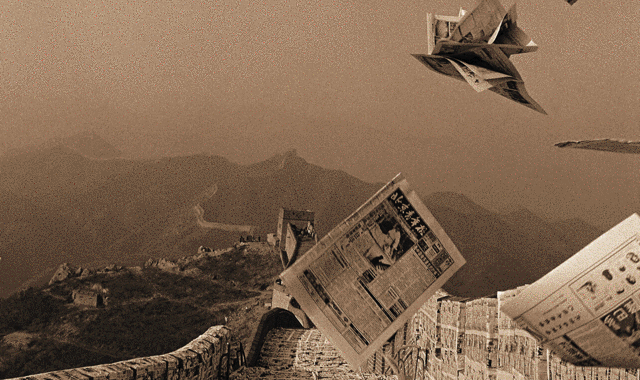
Wang Youshen is always tagged as the Artistic Director of Beijing Youth Daily and contemporary artist. In 2018, Wang Youshen resigned from Beijing Youth Daily where he had worked for 30 years and developed a new working profession. In the spring of 2022, his solo exhibition “Codes of Culture” was inaugurated at the Beijing Inside-Out Art Museum. Only via SMS and emails, can most people get in touch with Wang Youshen. This senior media person has profound sensitivity and even vigilance towards media and communication which pervades the questions he has tried to put forward in the whole exhibition, and it also points to the kernel expression in the artist’s creation.

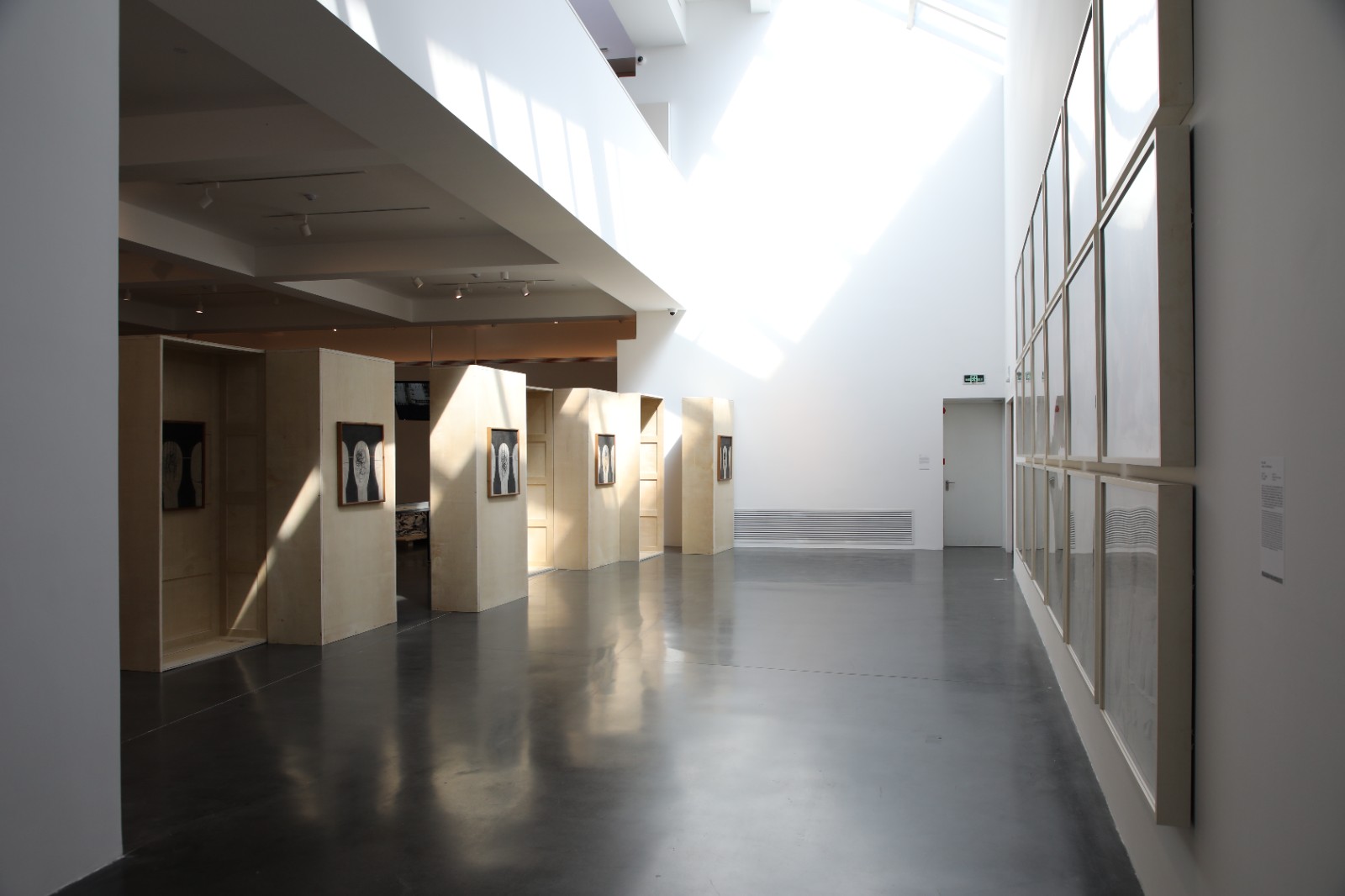 Exhibition View of “Wang Youshen: Cultural Codes” (Photo Courtesy Beijing Inside-Out Art Museum)
Exhibition View of “Wang Youshen: Cultural Codes” (Photo Courtesy Beijing Inside-Out Art Museum)
The exhibition is curated by Carol Yinghua Lu, Director of the Beijing Inside-Out Art Museum, art historian and curator. It can be seen that the Inside-Out Art Museum has tried to research contemporary art during the 1990s through specific areas and artist cases from Discordant Harmony: Observations of Artistic Practices in East Asia at the Transition in 2017. This case study of Wang Youshen’s art also belongs to the research sequence following that. The entire space of Beijing In-between Art Museum is divided into upper and lower layers by “Wang Youshen: Codes of Culture”, trying to study Wang Youshen’s “materials” with space rather than time clues. The exhibition extracts “expression” and “means” from the sequence of his creations with a large number of symbols, and they are further organized into a “parallel universe” with two clues that go hand in hand.
The “Decoding” Journey in “Codes of Culture”
The exhibition section on the second floor, “From the Removal of Meaning to Meaninglessness”, includes nearly 20 works created by Wang Youshen from the late 1980s through to 2017. From his earlier practice in the Student Photography Association of the Central Academy of Fine Arts in the 1980s, to the period he started to work for the Beijing Youth Daily after he graduated from CAFA. A large number of works showing the relationship between the media industry and social landscape in the 1990s are mainly concentrated on the second floor of the exhibition hall. In the exhibition hall, images are everywhere, and they are dedicated to showing intimate or unfamiliar social scenes and historical fragments, and the title of the exhibition “Codes of Culture” is just as it suggests.
Wang Youshen tries to take images as a carrier while placing images as symbols of cultural products in different contexts, thereby triggering meaning transformation. It is also this subtle moment of transformation that inspires the artistic effect Wang Youshen tries to achieve in his creations.
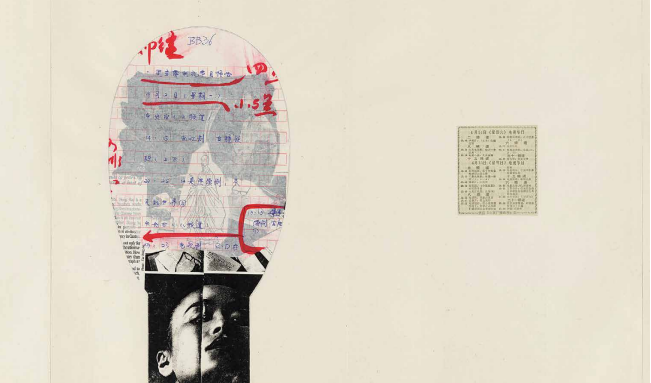
Wang Youshen, Portrait Series, 1990
Mixed Media on Board, 67×67cm
(Photo Courtesy Beijing Inside-Out Art Museum)
In 1988, Wang Youshen graduated from the Central Academy of Fine Arts with a degree in Comic Drawing. Right after that, he got a job at Beijing Youth Daily. Thereafter, “newspaper” has appeared and become the most prominent icon in Wang Youshen’s work in fact with extremely high frequency, “Newspaper·Reading” (1993) has the dual attributes of behavior and photography. With newspapers are covered all over the screen, such as clothes and wallpaper, which can be used, consumed, and are hard to break away from but can be thrown away.
The only identifiable information is the headlines on the front pages. The print media in the work indicates that careful reading and intensive reading are becoming impossible. Therefore, newspapers are abstracted from the medium of information transmission into pervasive cultural symbols, which experiences the repetition of synonyms in different contexts in “Newspaper Series”, deconstructing the significance of this symbol as representing the mainstream ideological authority at the cultural symbolic layer. Just as in “Newspaper·Reading”, the “mainstream voice” has become an everyday thing at your fingertips, and the veiled newspaper readers have become the “neurotics” of the epoch.

Wang Youshen, Newspaper·Reading, 1993
Performance, Photograph, 185×127cm, 70×48 cm
(Photo Courtesy Beijing Inside-Out Art Museum)
This sense of irony and similar creative logic has already appeared in Wang Youshen’s earlier “Newspaper·Curtain”. As a pattern, newspapers are neatly arranged and printed on cotton cloth and become a pair of curtains. As an artist in the system of mass media, he once again chose a more straightforward approach than metaphors, to be alert to the information flow that invades the private sphere and the reality that the information flow may obscure.
Throughout the 1990s, major print media developed rapidly and occupied public life and the market. Print media made information visible and accessible. The invisible power relations in the process of information dissemination become visible to the naked eye through the transformation of the artist. Thus, in the era of live streaming it loses its materiality so which category of art can reveal its essence?
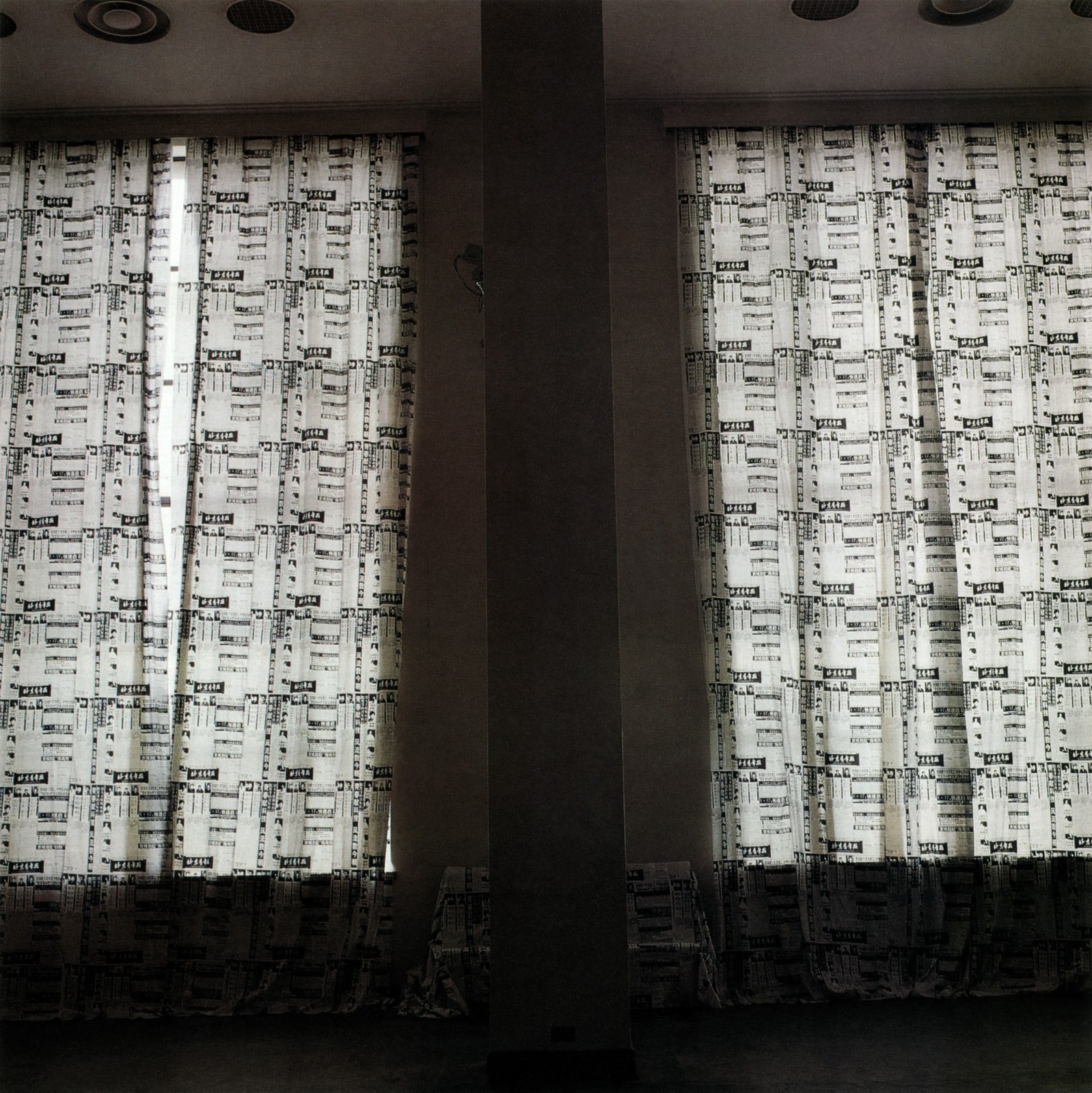 Wang Youshen, Newspaper·Curtain, 1991-1993
Wang Youshen, Newspaper·Curtain, 1991-1993
Silkscreen, Cotton Cloth, Photograph, Manuscript
Dimensions Variable (Photo Courtesy Beijing Inside-Out Art Museum)
Due to the working habits of media person and the preference for photography, Wang Youshen has always taken pictures and recorded moving images whenever he pleases, which makes the images in his works often have a sense of immediacy, and eventually presents an indelible social scene. Whether instinctively believing in photography or suspiciously believing in “editing”, the audience may embark on two different paths of “exposure” of reality. “Washing·Time Difference” may be a straightforward one of Wang Youshen’s “Washing Series”, based on “washing out photos”, which is the opposite of producing photos.
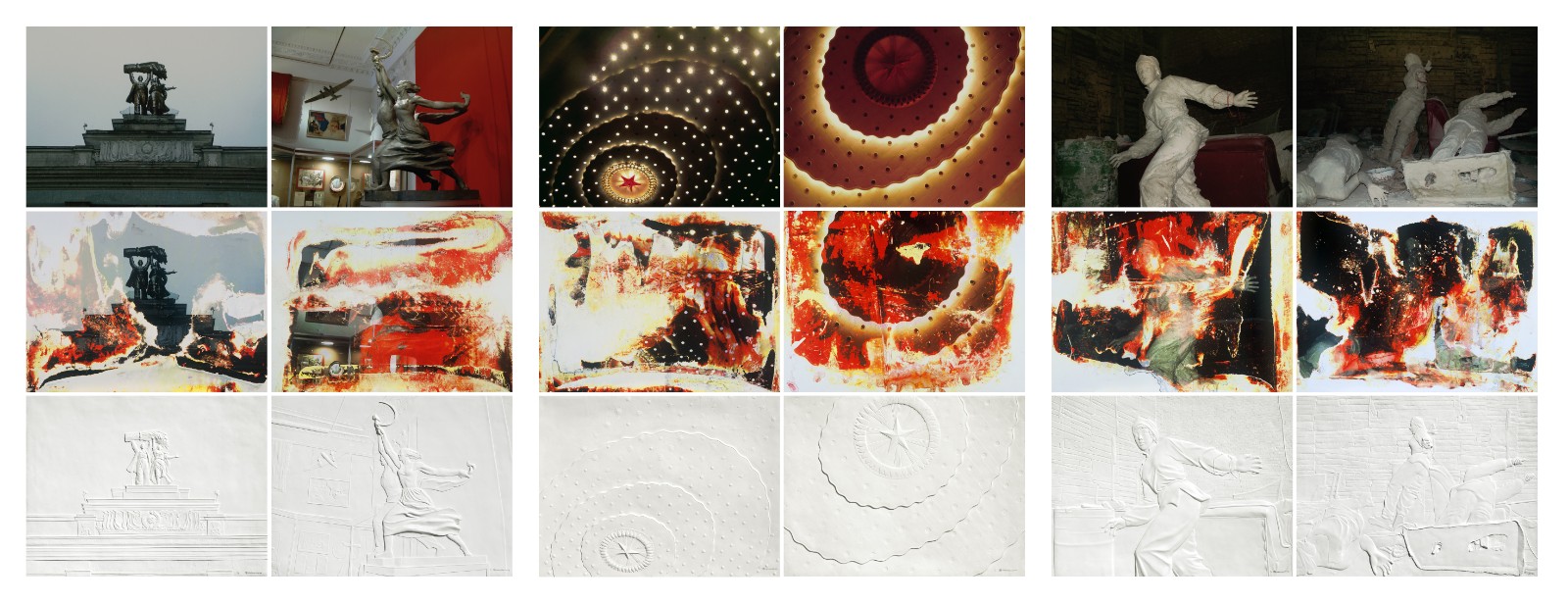
Wang Youshen, Washing·Time Difference, 2006-2008
Photograph, Water, Fiberglass, 120×90cm
(Photo Courtesy Beijing Inside-Out Art Museum)
“Washing·Time Difference” displays 18 images in three groups, the first two columns featuring the Soviet-style socialist worker-peasant-soldier statues displayed in the Red Square museum, the two columns in the middle featuring the All Together dome of the Great Hall of the People in Beijing, and the last two columns depicting abandoned worker-peasant-soldier sculptures in the artist’s studio in Beijing. The second row, on the other hand, represents how the original photographs have been developed over a period of time, the four edges of the photographs are mostly faded, and the subject matter is obscured by blocks of colors in yellow, black, orange, and red. Since it is difficult to identify, it also has the appearance of “painting” photography in form.
If associated with his practice in conceptual photography with his classmates and friends including Hong Hao, Liu Qinghe, Chen Shuxia at the Student Photography Association of the Central Academy of Fine Arts. “Washing” also means the superposition of creativity. On the basis of “removal of meaning”, superimposing some artistic concept points to the “meaninglessness”. The results pointed by washing are displayed in a more straightforward manner in the third row of photos. Wang Youshen restores the original photos to FRP reliefs made in equal proportion and the images return again with a simple and prominent appearance. Correspondingly, the documentary details have been greatly simplified, indicating a three-stage process from documentary, conceptualization, to monumental purification, through which “images create gods”.
In his work, Wang Youshen applies a lot of images that are often involved in events. They are an integration of historical snapshots, fragments of memories and personal experiences. For Chinese audiences with profound “decoding” ability, they can undoubtedly have a more extended thinking and even “pleasure”, not the other away around.
 Exhibition View of “Wang Youshen: Cultural Codes” (Photo Courtesy Beijing Inside-Out Art Museum)
Exhibition View of “Wang Youshen: Cultural Codes” (Photo Courtesy Beijing Inside-Out Art Museum)
“Drying·Military Clubhouse”(1997) was created by the artist for Another Long March with an exhibition of Chinese conceptual art in the city of Breda, the Netherlands. This exhibition is also an important collective appearance of Chinese conceptual artists in the international art world. Another Long March is located in an abandoned military camp not far from the city center in the Netherlands, and has a complex history. It is not only the largest military camp in the history of the Netherlands, it was garrisoned by German troops during World War II, and in the 1990s, it was also used to receive refugees from the Bosnian War, and after the war, it was transformed into an open public place.
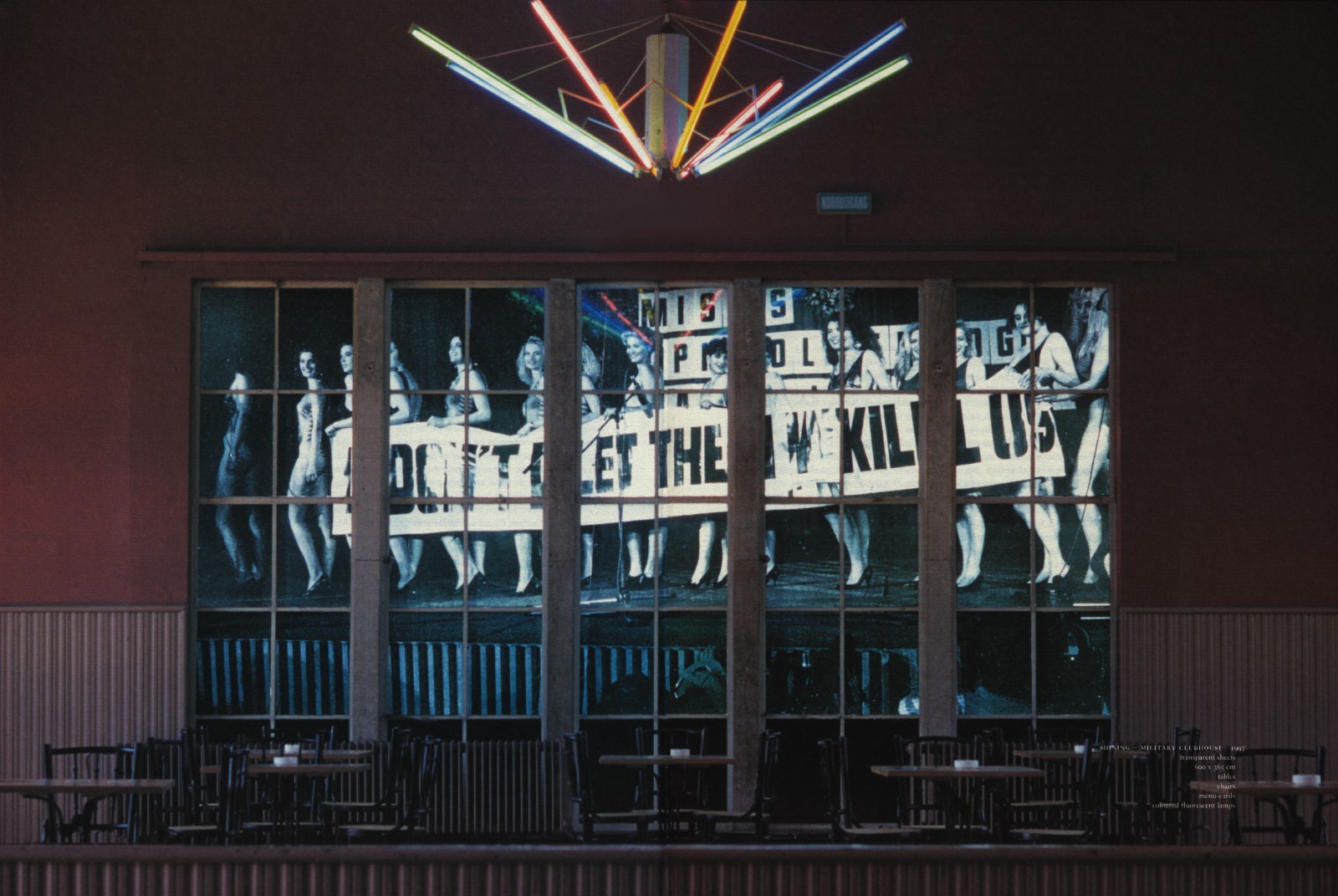 Wang Youshen, Drying·Military Clubhouse, 1997
Wang Youshen, Drying·Military Clubhouse, 1997
Photograph, Dimensions Variable
(Photo Courtesy Beijing Inside-Out Art Museum)

Wang Youshen, Draft for Drying·Military Clubhouse, 1997
Photograph, Dimensions Variable (Photo Courtesy Wang Youshen)
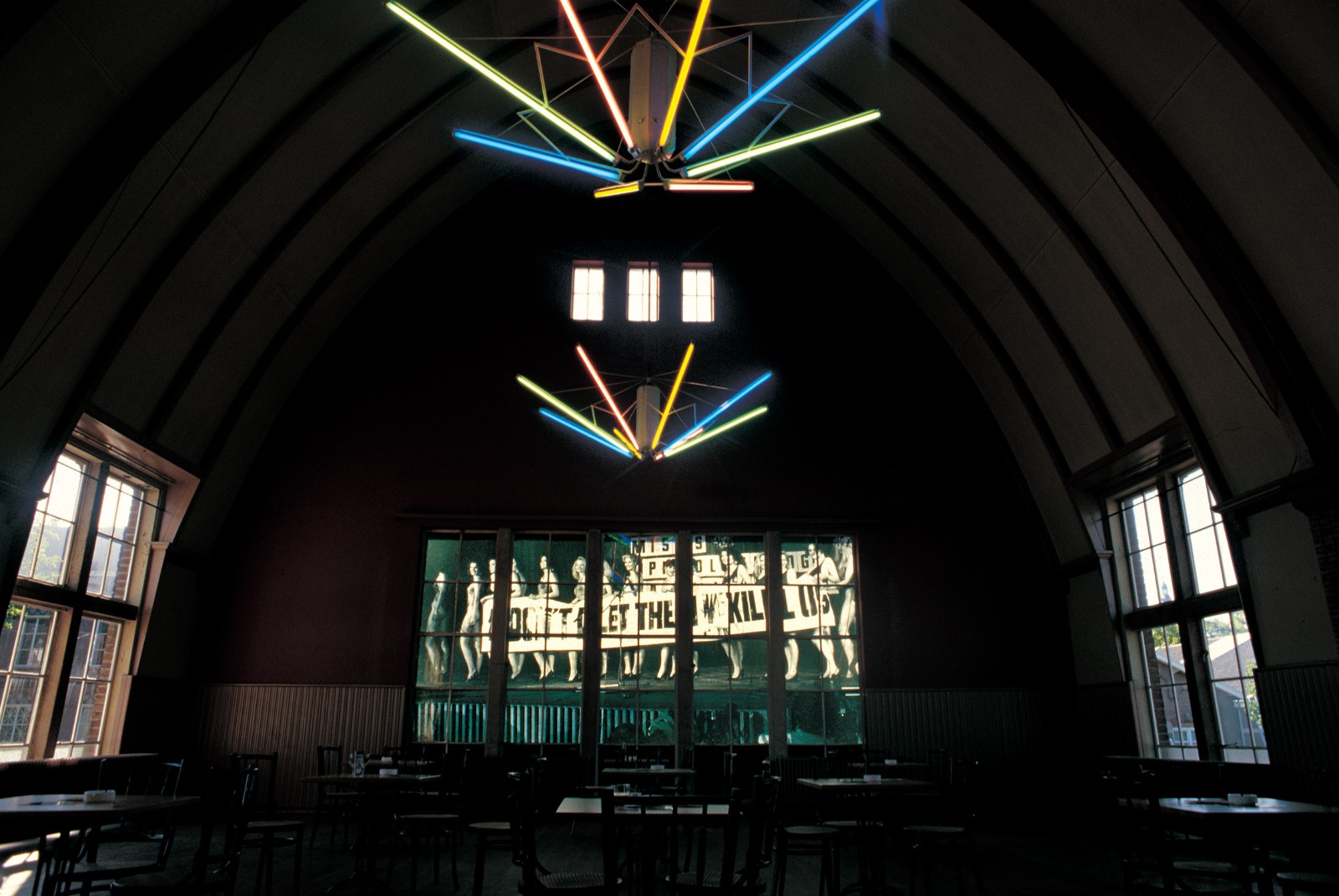 Wang Youshen, Drying·Military Clubhouse, 1997
Wang Youshen, Drying·Military Clubhouse, 1997
Photograph, Dimensions Variable
(Photo Courtesy Beijing Inside-Out Art Museum)
Based on his sensitivity to specific historical sites and his response to history, Wang Youshen uses his work to restore the abandoned military barracks to the club scene of its colorful heyday. On the huge windows of the club that once served as a church, the artist covered it with a magnified film of an underground beauty pageant in Sarajevo.
In the photo, the beauty pageant ladies were holding a banner with the words “Don’t let them kill us”. As the artist puts it, the “state of emergency” seems to be timeless. “The circumstances and conflicts at that moment seem to be projected to this day. I don’t think this is a coincidence.”[1] History and the present have acquired a new context at the same venue during different periods. The original question put forward by the artist with the work in 1997—“How can we restore our daily happiness?” has been renewed in a context again at this exhibition in 2022.
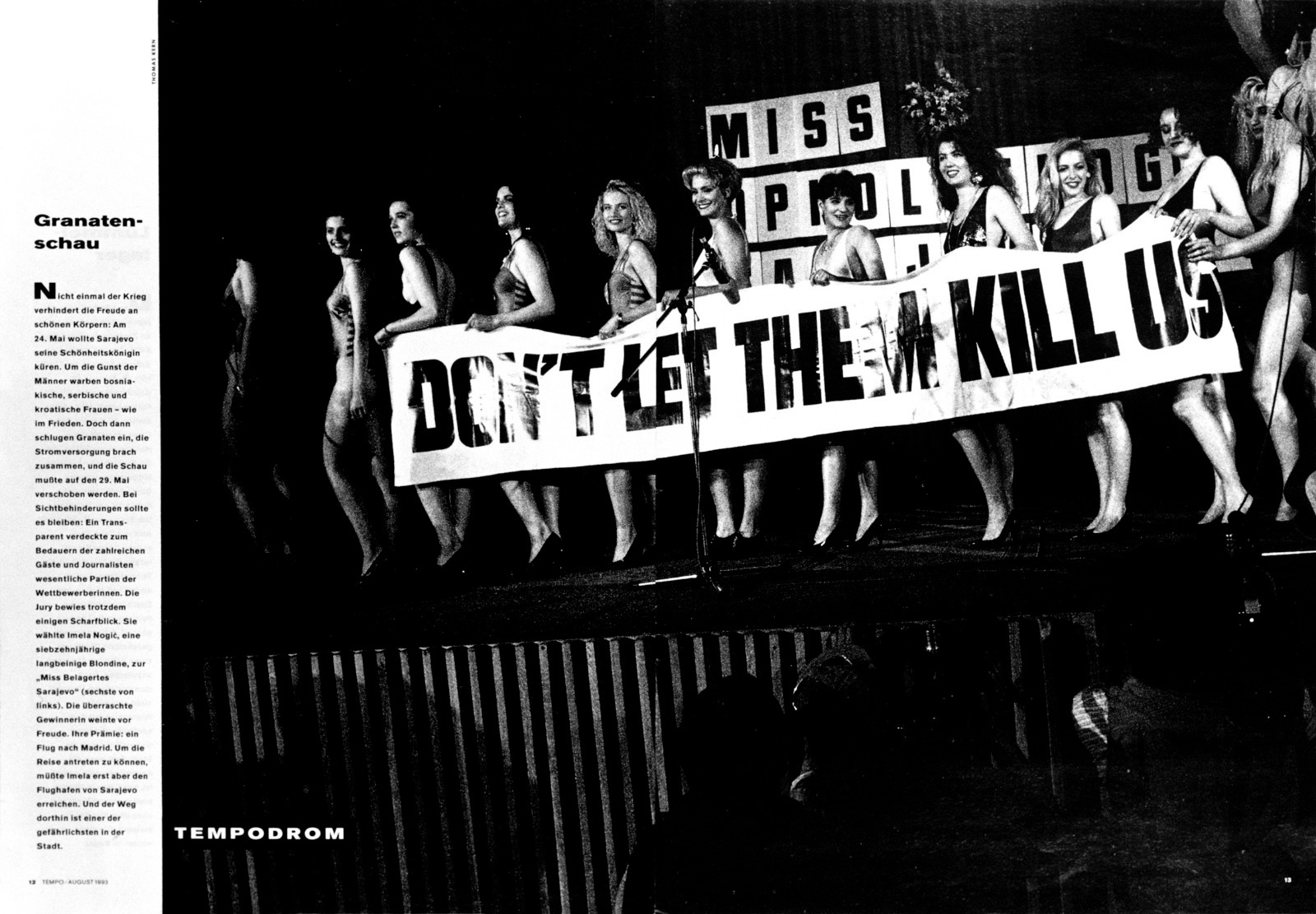 Wang Youshen, Drying·Military Clubhouse, 1997
Wang Youshen, Drying·Military Clubhouse, 1997
A News Photo (Photo Courtesy Wang Youshen)
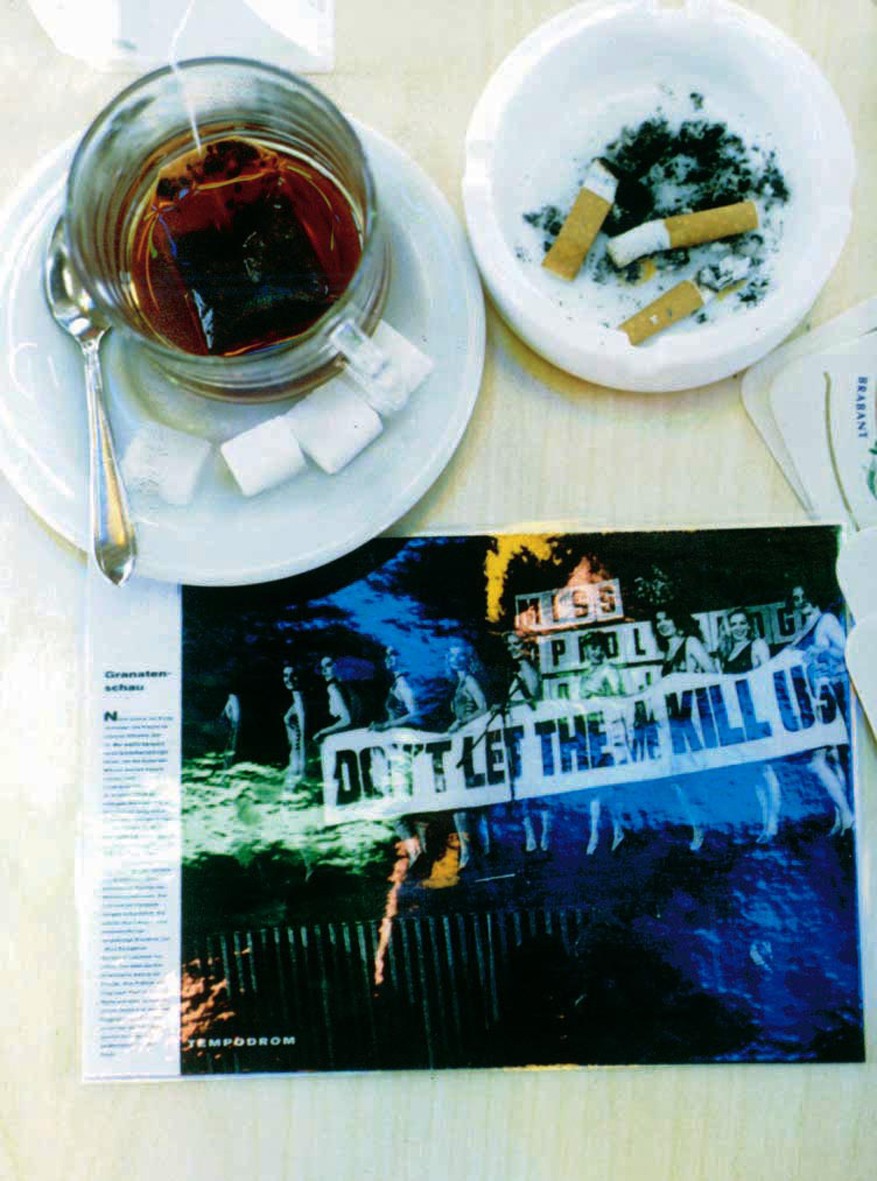
Wang Youshen, Drying·Military Clubhouse, 1997, Wine List
(Photo Courtesy Wang Youshen)
How to Convert “Work” into “Medium”?
Unlike the works displayed on the second floor which emphasize the medium as the carrier of symbols, the section on the ground floor is entitled “From Image Processing to Image Disintegration”, with nearly 10 groups of works, presenting the artist’s “media view” so far.
The evolution of the artist’s creative method is clearly visible—from the 1980s onwards, creating images, “washing” them, and around 2010, introducing “activism colors” beyond images and within working methods. Whether creating or destroying images, recording or deconstructing, professional or artistic creation, the artist turns himself into a form of “production device” of images, providing a highly conscious production with a critical attitude rather than emotional capture. It is not inappropriate to regard this process as “Wang Youshen’s journey in media interests and creative methods.”
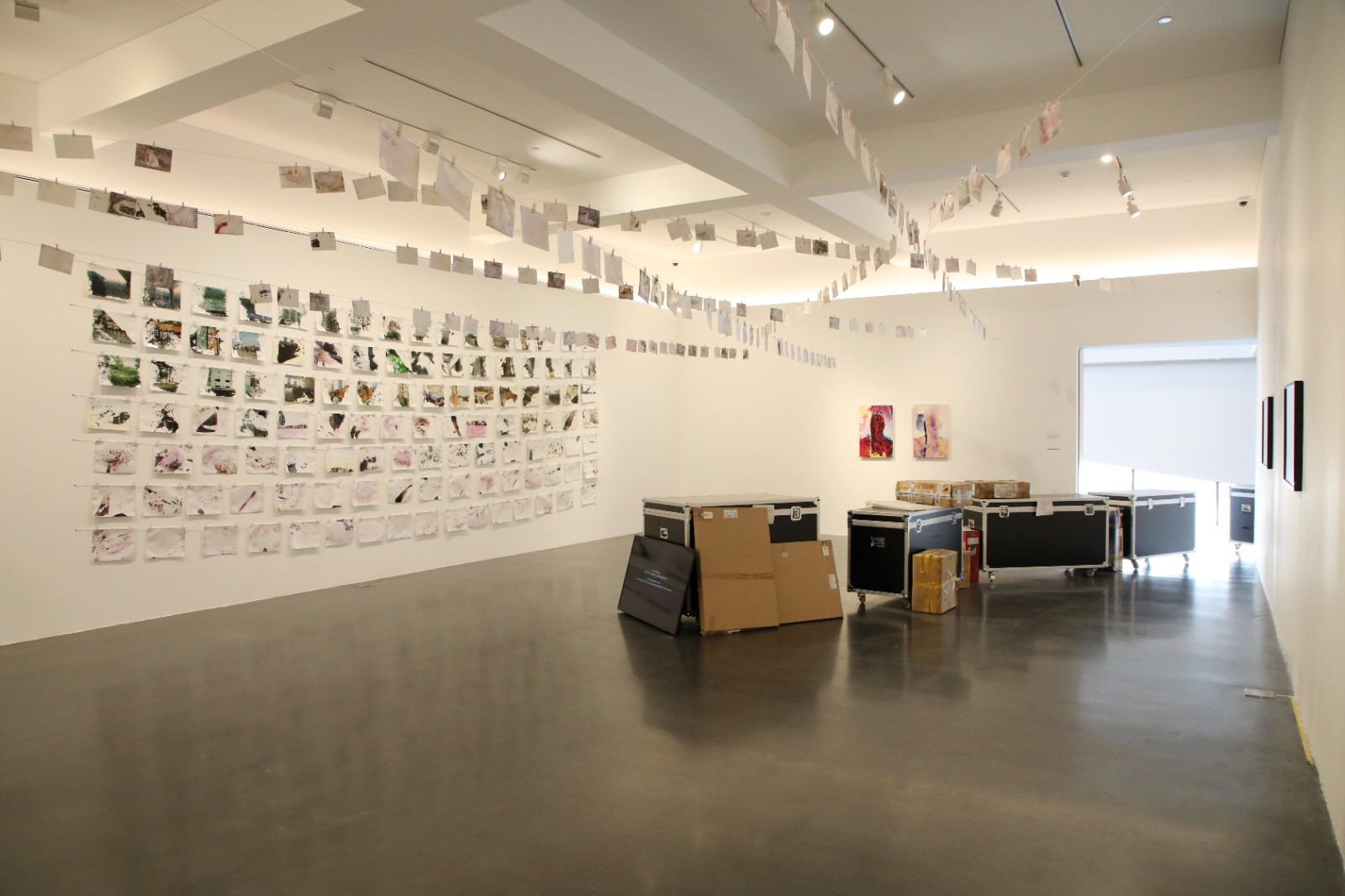 Exhibition View of “Wang Youshen: Cultural Codes” (Photo Courtesy Beijing Inside-Out Art Museum)
Exhibition View of “Wang Youshen: Cultural Codes” (Photo Courtesy Beijing Inside-Out Art Museum)
There are few single images in Wang Youshen’s works and images often appear in groups and are intrinsically related. This preference may be related to the subtle influence he received during his major in Comic Drawing at the Central Academy of Fine Arts. Wang Youshen, who originally wanted to apply for the Beijing Film Academy, but he was valued by He Youzhi, when he was graduating from the High School Affiliated to the Central Academy of Fine Arts, and he majored in Comic Drawing when the Department was initially founded at the Central Academy of Fine Arts. At that time, the social influence of comic drawing as a medium far exceeded that of the emerging medium of film. The openness and freedom encouraged by the Department has stimulated Wang Youshen’s wider interest in narrative structure research and media experiments.


 Wang Youshen, Variation 2, 1987
Wang Youshen, Variation 2, 1987
In 1987, Variation 2 expresses the continuity, fragmentation and temporal nature of ideas and concepts through the comic strip format. (Photo Courtesy Wang Youshen)
Wang’s preference for “continuous moving images” and photography also comes from the influence of films that he received while studying at CAFA. In this exhibition, “Blowup | Red Desert” composed of the comic strip and Giclee print on paper can be seen as an artistic self-disclosure of the origin of artistic creations by the artist. This is a work across manuscripts, newspaper clippings, and collages. In 2018, Wang Youshen was invited by Hong Zicheng, Liu Ding, and Carol Yinghua Lu to contribute to the anthology Where Did I Miss You. The manuscript required “introducing your situation in a personalized style and words, including your research specialty, mentality, and artistic philosophy.” The manuscript is produced using a comic strip, and his dual identity as an artist and as a media person was also enlarged through the final frame of Michelangelo Antonioni’s film Red Desert (1964) and combined with an interview by the Asian Art Archive in 2009.
 Wang Youshen, Blowup | Red Desert, 1984-2018
Wang Youshen, Blowup | Red Desert, 1984-2018
Comic Strip, Giclee Print on Paper, 24-inch
(Photo Courtesy Beijing Inside-Out Art Museum)
Compared with visual art, films can frame and present the creator’s artistic conception in the dimension of time and space in a more comprehensive and complete way. This fundamental feature makes Wang Youshen deeply attracted to films. Since a department of photography has not been established by the Central Academy of Fine Arts, Wang Youshen, Hong Hao, Liu Qinghe, Chen Shuxia and other classmates and friends spontaneously organized a photography hobby group, which did not only became an area for their video experiments, but it was also regarded by future researchers as the earliest group of conceptual photography in China.
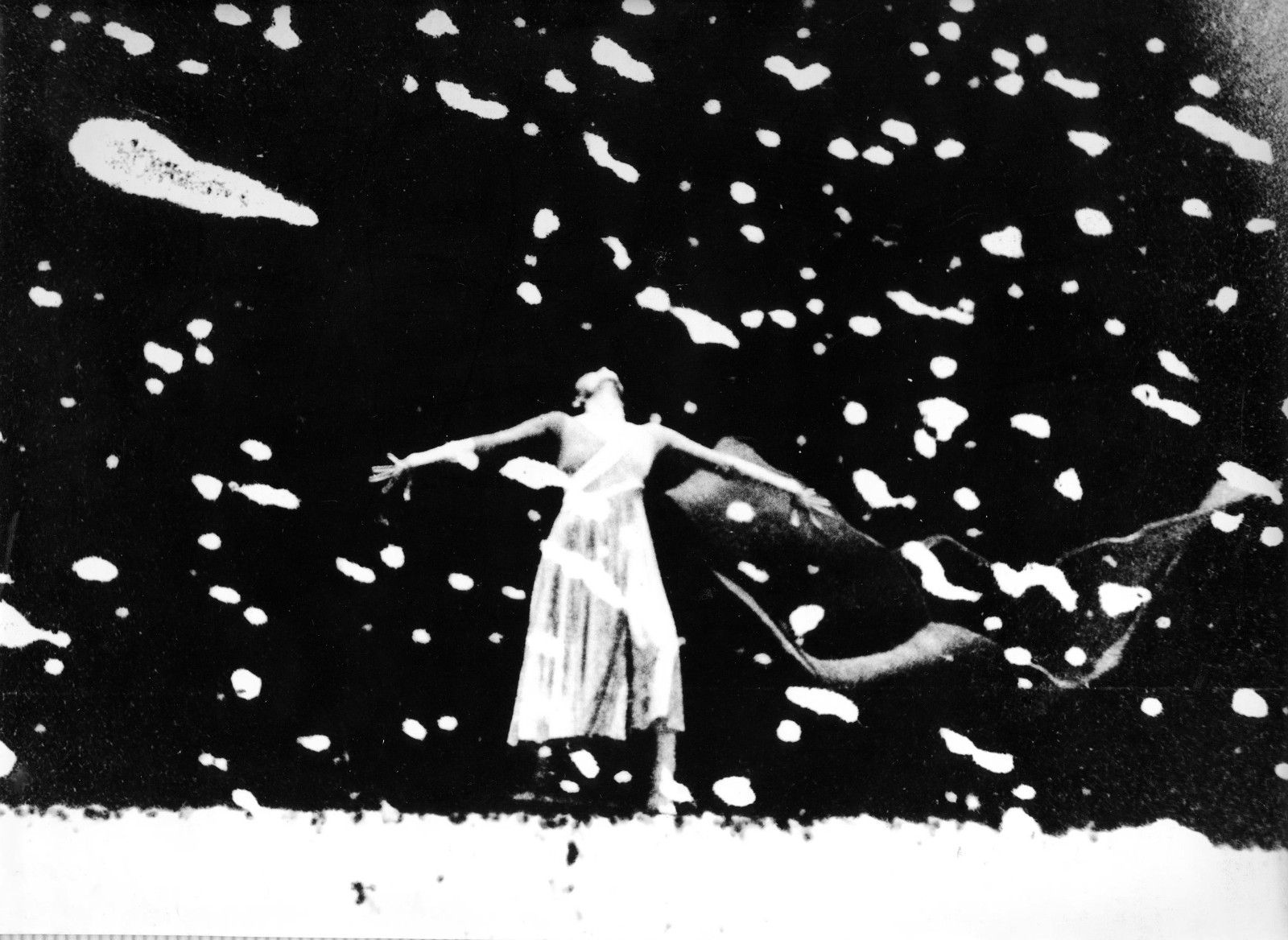 During the activities of the Student Photography Association of the Central Academy of Fine Arts in 1987, Wang Youshen’s photography Sprouting (Image Courtesy Wang Youshen)
During the activities of the Student Photography Association of the Central Academy of Fine Arts in 1987, Wang Youshen’s photography Sprouting (Image Courtesy Wang Youshen)
 During the activities of the Student Photography Association of the Central Academy of Fine Arts in 1987, Liu Qinghe’s photography Inner Heart (Image Courtesy Liu Qinghe)
During the activities of the Student Photography Association of the Central Academy of Fine Arts in 1987, Liu Qinghe’s photography Inner Heart (Image Courtesy Liu Qinghe)
 During the activities of the Student Photography Association of the Central Academy of Fine Arts in 1988, Hong Hao’s photography Aisle (Image Courtesy Hong Hao).
During the activities of the Student Photography Association of the Central Academy of Fine Arts in 1988, Hong Hao’s photography Aisle (Image Courtesy Hong Hao).
Compared with other participants in the group, photography has gradually taken root in Wang Youshen and Hong Hao’s creations. In the conceptual art creations by Wang Youshen after he started working in the 1990s, he gradually moved from the “story” structure of “continuity and temporality” in the style of comic strips and films, to creative stage with the expression of “fragmentary and instantaneous” events. [2]
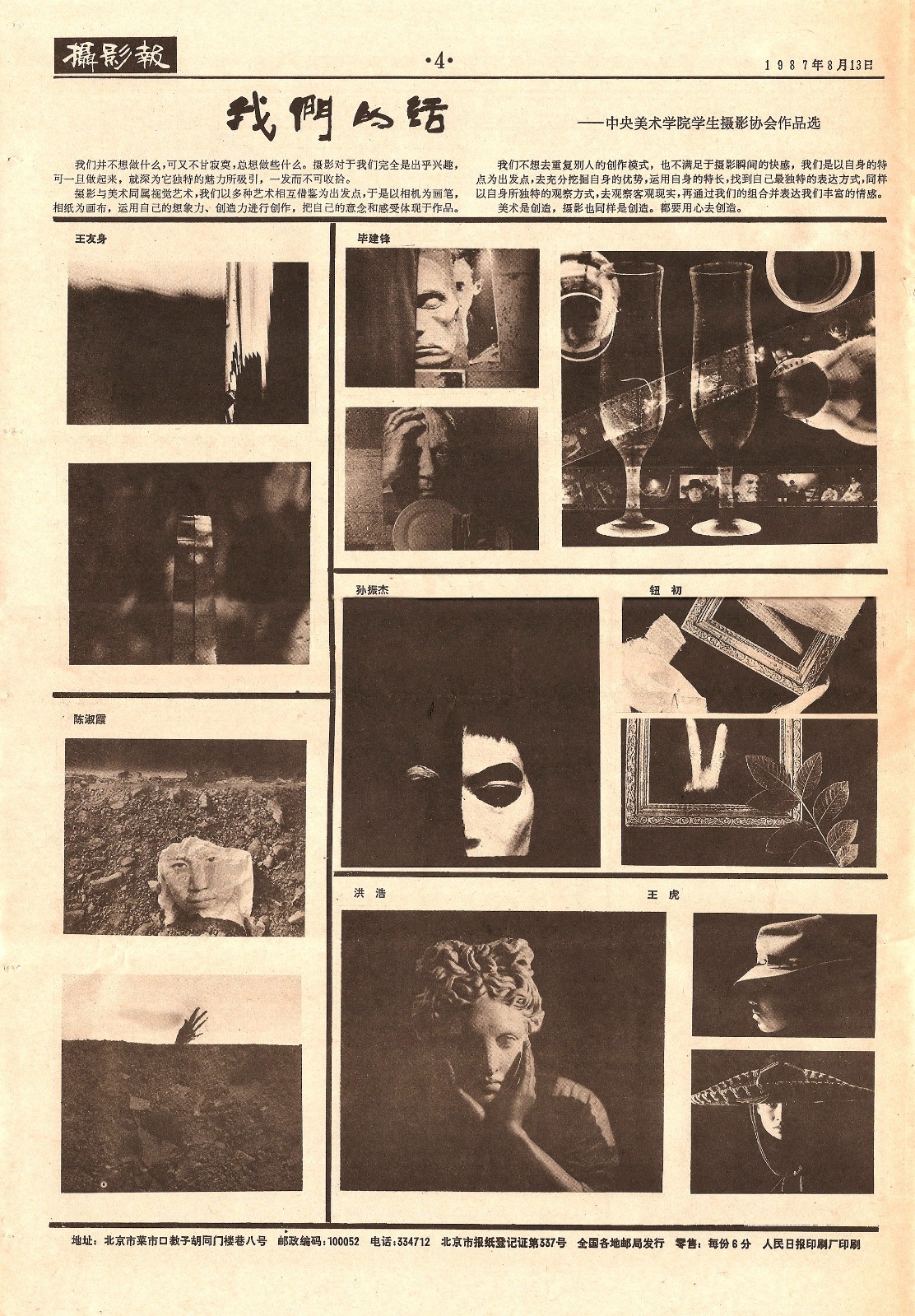
Our Words: The Student Photography Association of the Central Academy of Fine Arts Selected Works Original Newspaper, 1987, Newspaper, 39×27cm
Another medium might be “work.” In Huang Zhuan’s view, “the medium does not only refer to the tool he uses, but also the object of his research.” The work of the media industry also has a dual significance for Wang Youshen: “It is both his profession and the way he works in art.” [3] Wang Youshen’s inability to “wash” the traces of the newspaperman made him inevitably become, as with his own joking phrase, “an image production library.”
During his career as a journalist over the past 30 years, the long-term, mass production and processing of images has almost become his instinctive reaction, which is shaped by the profession. Conversely, it may be worth noting Wang Youshen’s reverse “shaping” of work. If “work” is also regarded as a medium, it may be interesting to observe how the artist makes full use of the plasticity and possibility of this “medium.”
Beijing Youth Art Shop was a derivative space from the work (Beijing Youth Art) Office presented in the exhibition “Self-Criticism” in the Beijing Inside-Out Art Museum in 2017. The store showed the artworks of Beijing Youth Artists as an expression of the business culture of Beijing Youth Cooperation. In the current solo exhibition of Wang Youshen, the artist presents his collection of Beijing Youth Artists’ works including himself in the original exhibition space five years ago.
 Wang Youshen, (Beijing Youth Art) Shop, 1991-2022
Wang Youshen, (Beijing Youth Art) Shop, 1991-2022
Beijing Inside-Out Art Museum (Image Courtesy Wang Youshen)
 Offices at Beijing Youth Daily
Offices at Beijing Youth Daily
The original intention of this context replacement originated from the artist’s annual work summary in 1992. “Self- Criticism and its Entry Rules” (published in '92 Volume of Beijing Youth Daily), which aimed at the reflection and introspection of the “Beijing Youth Daily phenomenon” in the Chinese news market in the early 1990s. In 2017, “Beijing Media” (01000.HK), which became the first Chinese media to issue shares in its stock after completing its capital operation, it then faced the existential crisis under the digital and multimedia changes, just like other global media groups.
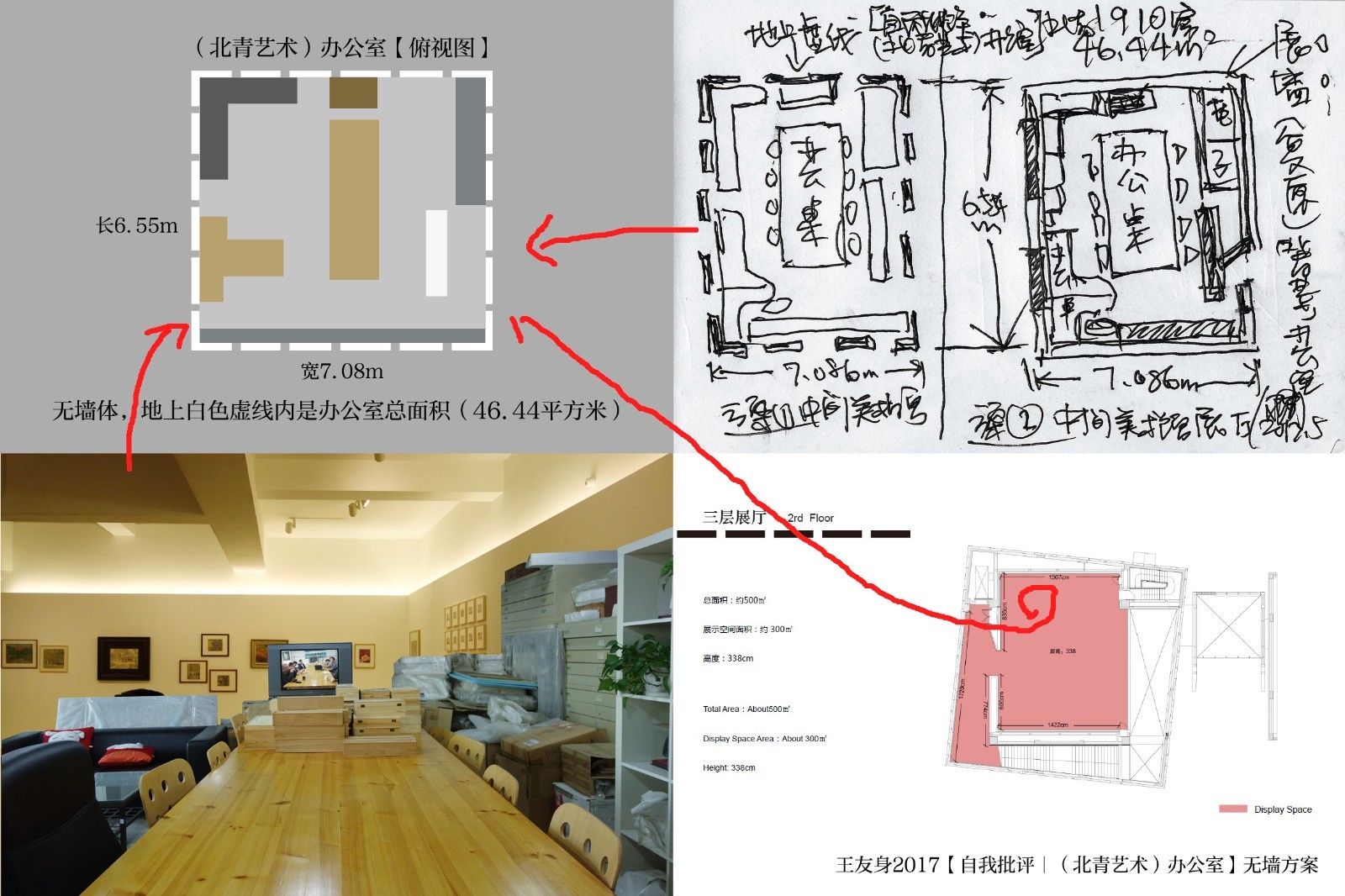 Wang Youshen, (Beijing Youth Art) Office, 1992-2017
Wang Youshen, (Beijing Youth Art) Office, 1992-2017
Work, Photograph, Video, Calendar, Document, Dimensions Variable
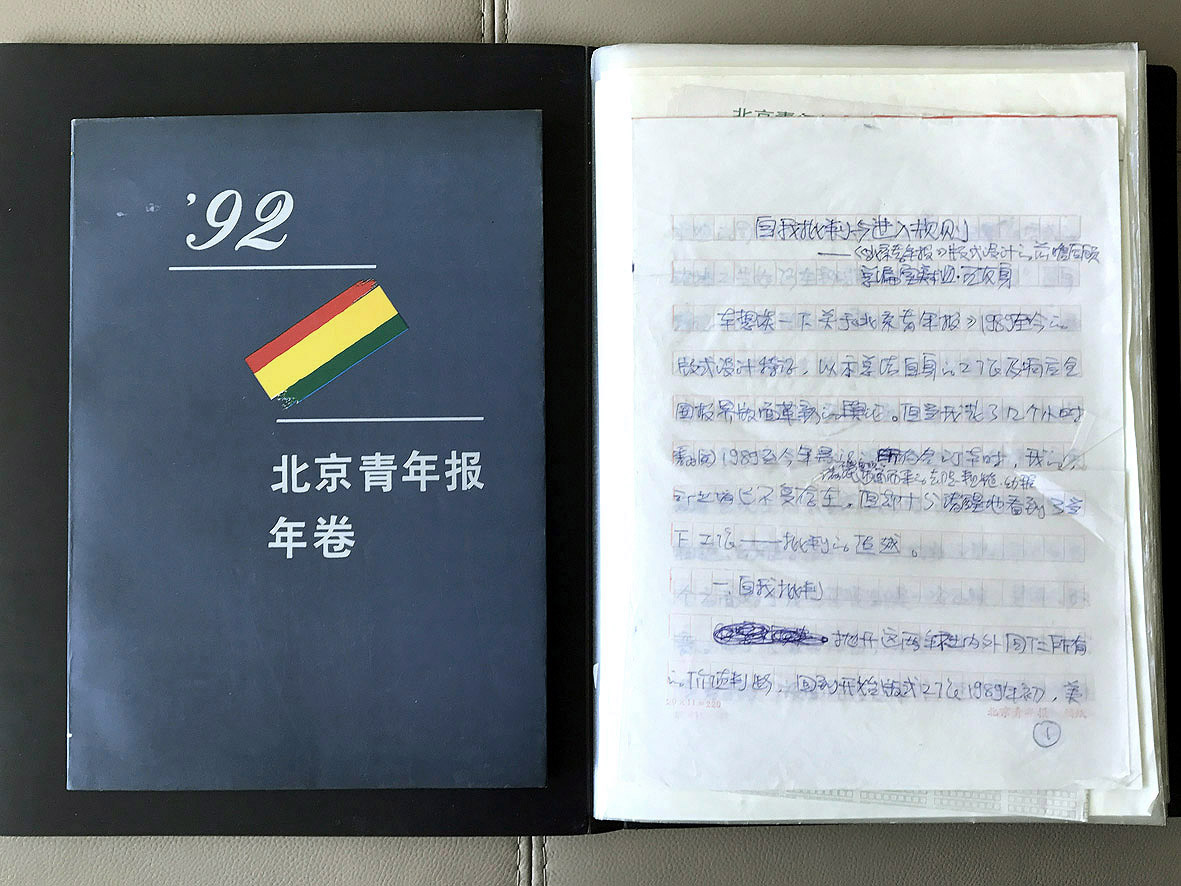 “Self- Criticism and its Entry Rules” (published in '92 Volume of Beijing Youth Daily)
“Self- Criticism and its Entry Rules” (published in '92 Volume of Beijing Youth Daily)
In fact, this sort of action appeared earlier. In 1993, Wang Youshen put his “Newspaper Series” on the advertising space, “I think it is a very interesting thing. The starting point was not what I was actively seeking but it was passively given to me. Actually, it was originally a task from Beijing Youth Daily. We were going to publish a special issue for the celebration, and we needed to create an advertisement. My proposal was accepted and we spent about 60,000 yuan on a full-page image advertisement in the Press and Publication News (Xinwen Chuban Bao). But then I thought since it was a task, maybe I can turn it into my own art creation at the same time.”[4] This plan, which was costly in both personnel and budget, was successfully implemented in the real Badaling tourist attraction, and was finally published in Press and Publication News (Xinwen Chuban Bao) with the title of “Newspaper·Advertising”.
 Wang Youshen, Newspaper·Advertising, 1993
Wang Youshen, Newspaper·Advertising, 1993
Silkscreen printing, photo, 2.50×1.85m (Image Courtesy Beijing Inside-Out Art Museum)
Over the 30 years that he has spent in the newspaper industry, Wang Youshen has witnessed and participated in the complete stage from the rise to the end of the print media. All of Wang Youshen’s experiences are not only about personal experience, but also about how a conceptual artist who is interested in how his works intervene in social reality, how to explore and identify himself in society.
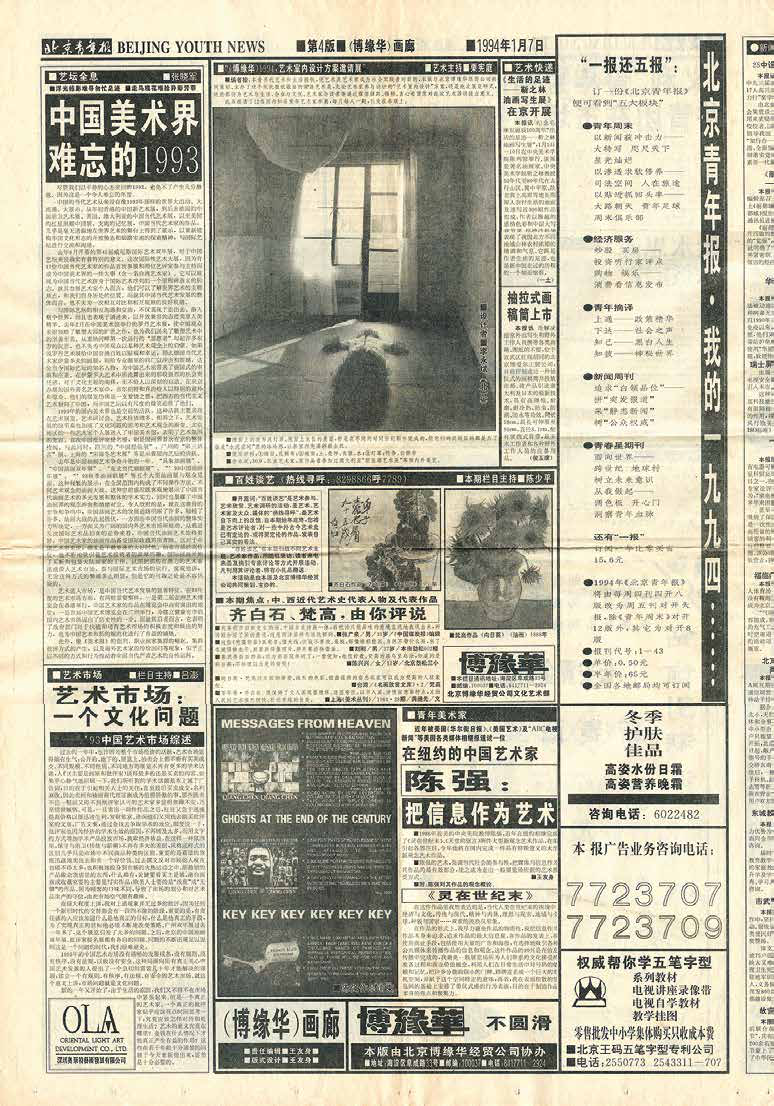
Beijing Youth Daily and newspaper vendors in front of Beijing Capital Gymnasium, photo by Lu Beifeng (Photo courtesy of the artist)
The so-called authority on the narrative possessed by the mass media, on another level, has become the object of the artist’s long-term reflexive confrontation, deconstruction and reflection in his creation—historical reality, news-directed national narrative and individual memory and experience, which together stimulate the artist’s imagination, become the source of his constant deconstruction and reconstruction impulse. As a creator who is keen on conceptual experimentation, Wang Youshen’s works are rarely motivated by emotions. “It is often the problem that motivates my creation” [5]. Fortunately, work can always provide people with more questions, rather than reduce them.
Based on years of thinking with “work” as the medium of realistic thinking, the form of dialogue between the artist and the world is gradually opening up, and gradually infiltrating the “activism” style of work methods.
A fairly typical case occurred in 1994, which was also the occasion when “commercial housing” was hotly launched. Wang Youshen, then Director for the Editing Office of Fine Arts, planned the “Boyuanhua 1994 Interior Design Art Proposals Exhibition”. This exhibition lasts for one year and presents an artist’s creative plan every month. The 12 artists participating in the exhibition were Li Yongbin, Gu Dexin, Wang Luyan, Yang Jun, Zhang Peili, Geng Jianyi, Song Haidong, Wang Jianwei, Li Qiang, Chen Shaoping, Wang Guangyi, Ni Haifeng. These projects belong to the conceptual art framework, and enter the public’s vision through the media space.
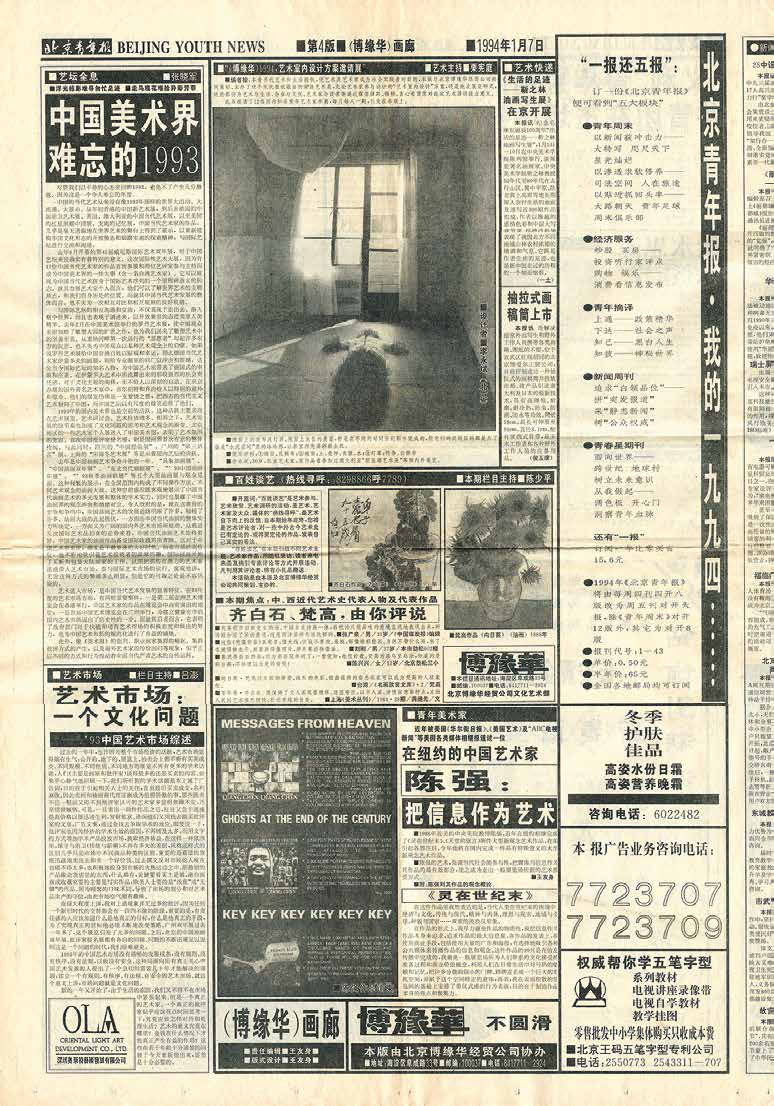
Boyuanhua 1994 Interior Design Art Proposals Exhibition, 1994
Newspaper, Postcard, Work Plan, Dimensions Variable
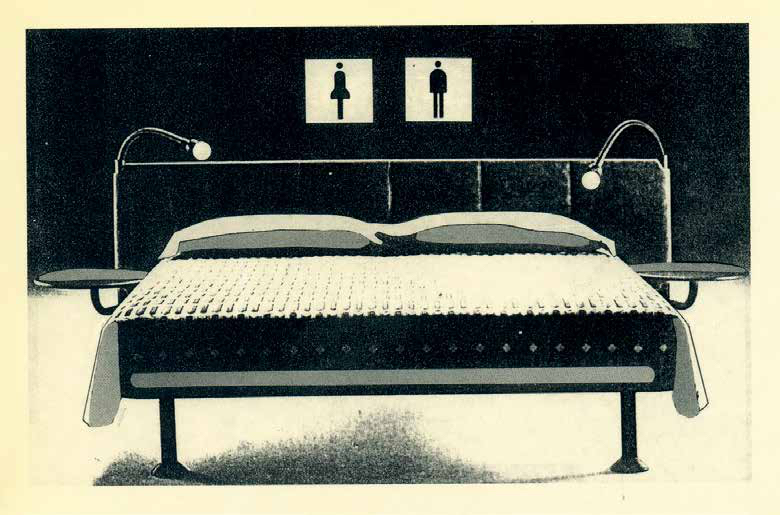
A Postcard Designed for Boyuanhua 1994 Interior Design Art Proposals Exhibition, 1994 (Image Courtesy Wang Youshen)
Similar to experiments with a cross-border nature, the reform of the format of Beijing Youth Daily led by Wang Youshen in the early 1990s cannot be missed. In the process of experimentation and exploration, Wang Youshen and other editors of fine arts jointly changed the old layout of newspaper, which was dubbed “the new school’s thick eyebrows and big eyes” at that time. Because of its modern layout style, it led the Beijing newspaper industry to imitate it. To a certain extent, the experimental and conceptual nature of art in the 1990s, through the diffusion of mass media, triggered a renewal of visual experience towards modernity.
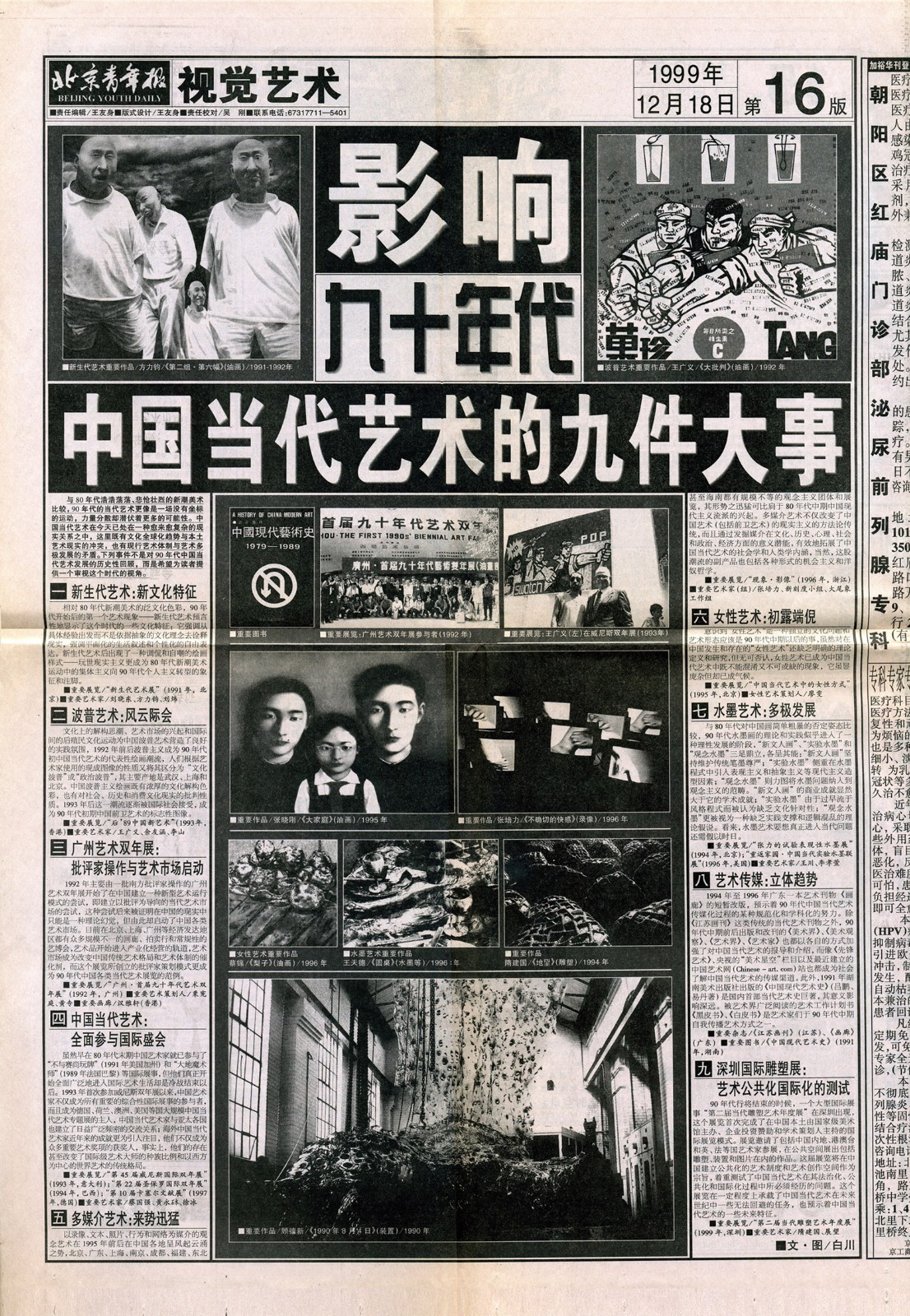
Wang Youshen, Beijing Youth Daily-Visual Art, 1999-1218
Editor + layout design, Image Courtesy Wang Youshen
“A Quiet Revolution” was the theme of Li Xianting’s description of his classmate and artist Chen Wenji in the 10th issue of Fine Arts magazine in 1987. Chen Wenji, as Wang Youshen’s tutor during his study of comic strips, had a great influence on Wang Youshen’s creation. “Contemporary art, as an experiment in the art world, requires a silent working attitude, constantly changing the surrounding environment and discovering the possibilities around it. This may be my character and my ability. I have always wanted to do what I can do. I am very willing to make a deal with all systems, and I also know when to exit and when to enter.” [6] Wang Youshen also sums up the state of creation he agrees with as “a quiet revolution.”
“Confronted with the marketization of the older generation of artists and the rise of young artists, middle-aged artists are often faced with an embarrassing situation that cannot be described, summarized and sorted out. I also hope to confront the question of how middle-aged artists continue to experiment and innovate.”[7] In this way, this exhibition is not a retrospective, but more like a “semicolon.”
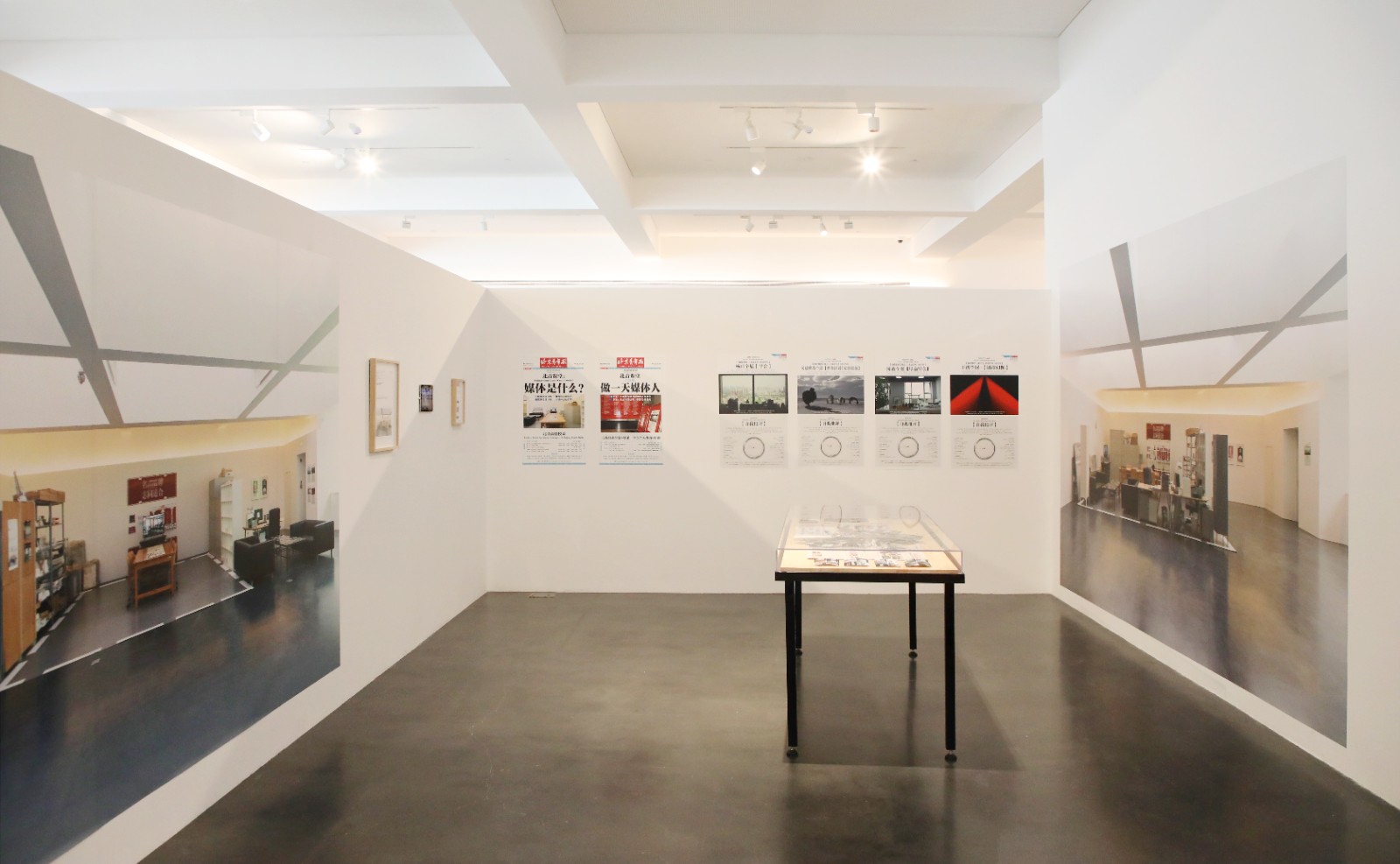 Exhibition View of “Wang Youshen: Cultural Codes” (Photo Courtesy Beijing Inside-Out Art Museum)
Exhibition View of “Wang Youshen: Cultural Codes” (Photo Courtesy Beijing Inside-Out Art Museum)
Wang Youshen’s “identity controversy” has gradually evolved to “characteristic.” Pi Li once wrote a rather precise description: “Unlike most of the artists we talk about today, Wang Youshen never seems to have become a ‘professional artist’ in the full sense of exhibition and sales of works for a living. But he is not just an ‘a(chǎn)mateur artist’ who takes art as a weekend hobby. Since the 1990s, the fact that he has almost witnessed important domestic and international exhibitions as an artist also reflects the evaluation and affirmation of him in the art world; and observing his works for nearly 30 years, we can see a complete, serious and rich creative sequence.”[8]
No matter what status they are in, the problem that artists are confronted with is not entirely caused by “identity”, professional artists cannot escape a lot of useless and necessary social interactions, amateur artists always seem too marginal, and a “job” often takes up a lot of time for artistic creation (this does make Wang Youshen’s creative cycle longer), but from another perspective, it also puts Wang Youshen in a blurred boundary between “art” and “non-art”, and it is possible for art to intervene in society from a flexible and ingenious perspective. It also provides a valuable reference for artists who are struggling to find a job.
Perhaps, in the end, art has nothing to do with occupation or non-occupation, or employment and flexible employment. It is about how the artist can continue to have an open and in-depth dialogue with the world, and how much “flexibility” and “consciousness” he can ultimately reflect.
Text by Mengxi, edited and translated by Sue/CAFA ART INFO
Notes:
[1][5][7][8] On March 28, 2022, it was edited according to the recording of an interview with Wang Youshen.
[2] Huang Zhuan, “Wang Youshen: The Information Energy of Conceptual Art”: Comments on Wang Youshen’s Solo Exhibition.
[3] Huang Zhuan, “Medium is Art”.
[4] Sheng Wei, “Media Studies: An Interview with Wang Youshen”.
[6] Pi Li, "The Temperature of Ideas: The Language Logic in Wang Youshen’s Artistic Creation”.
About the exhibition
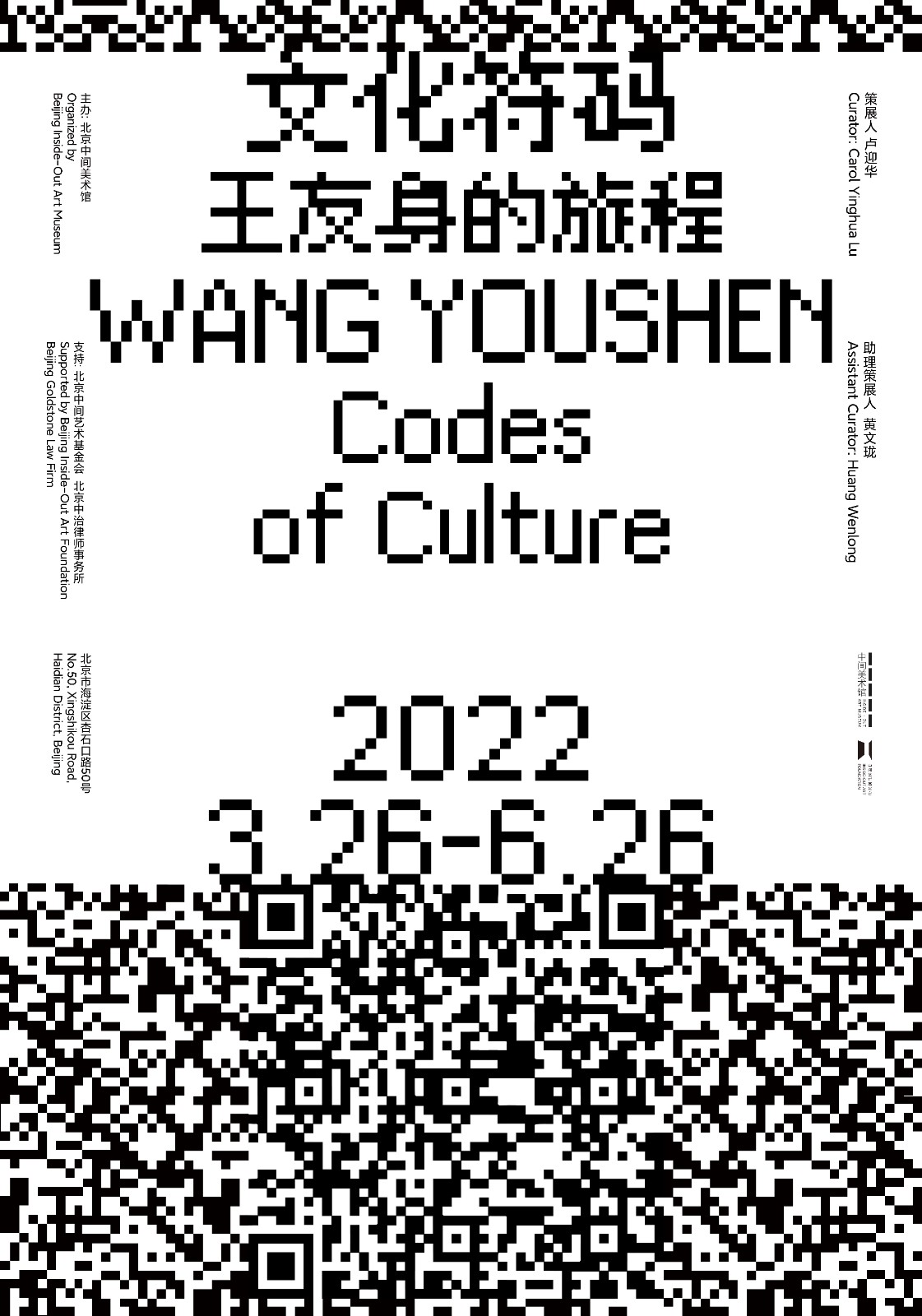
Curator: Carol Yinghua Lu
Dates: 26 March-26 June
Venue: Beijing Inside-Out Art Museum




























